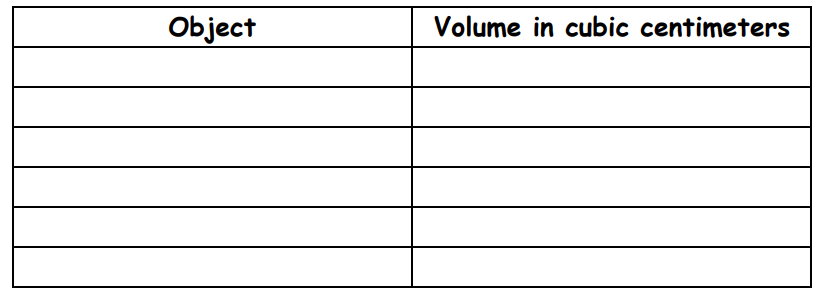Mathematics
Grade Levels: 3rd Grade, 4th Grade, 5th Grade, 6th Grade,
Topics: Measurement (volume)
Common Core State Standard: 5.MD.3, 5.MD.4,
Concepts:
· Cubic centimeter
Materials:(for each team):
· 5 rows of centimeter cubes
· a few rubber bands
· a clear plastic glass about half full of water
· a marker which will make visible marks on the plastic of the glass
· an extra cup of water
· a small collection of immersible, non-absorbing objects such as marbles, keys, etc.
Lesson:
Procedure: This activity is best done in teams of two or three students each.
Arrange the class in teams, and distribute the handouts, and the supplies for each team. Tell the teams to do steps #1 – 4.
Stop the teams after completion of step #4 and discuss what has happened so far. Make sure students can clearly explain why the water level went up when they put their finger in, and why it went down below its original level when they removed their finger (some water adhered to their finger).
Stop all teams again once step #7 is completed and ask the students to explain what has happened so far, and what the marks mean. Ensure that they understand that the marks represent the volumes of 5, 10, and so on “centimeter cubes”. Explain that another way to say that is “cubic centimeters”.
Allow the students to complete the remainder of the steps and report on their results. Make sure they use and understand the units “cubic centimeters” in their explanations.
Measuring Volume
You can use a ruler to measure the length of something, and a scale to measure how much something weighs. Is there a way to measure volume? Try this:
1. Use a clear plastic glass. Fill it about half full of water.
2. Mark the level of the water on the side of the glass with a marker.
3. Put your finger down into the water. What happens to the level of the water? __________________ Why? ____________
________________________________________________
4. Take your finger out. Is the level of the water back to where it started, or a little lower? Why? _______________________
________________________________________________
5. Add more water, if necessary, to bring the water level back to the first mark. You have nothing else in the water now, so write a “0”: next to your mark.
6. Use a row of centimeter cubes. Put one end down into the water so that exactly 5 cubes are in the water. Make another mark on the side of the glass at the level of the water. Write “5” next to
your mark.
7. Use another row of cubes, and put exactly 5 more cubes under the water (now two rows of cubes are in the water). Make a mark at the level of the water and write “10” next to your mark.
8. Repeat step #7, making marks for 15, 20, and 25 cubes. One way to do this is to use a rubber band to make a bundles of three, four, and five rows of centimeter cubes. Make sure the ends are even, and then put your bundles exactly halfway down into the water, so that 5 cubes from each row are in the water.
9. You have made a measuring instrument to measure volume. Put your finger back into the water. About how many centimeter cubes have the same volume as your finger? _____
10. Measure the volume of some other small objects. Make a list of them and their volumes below. After you measure the volume of each object and take it out of the water, be sure that you put water back into the glass to bring the level back to the “0” mark.

